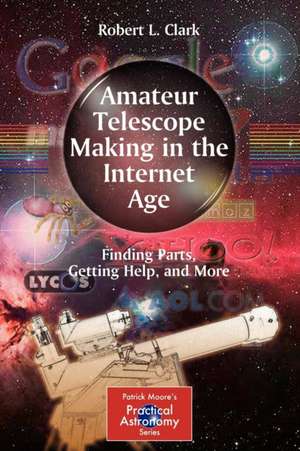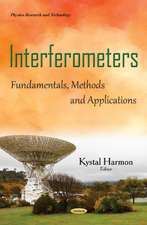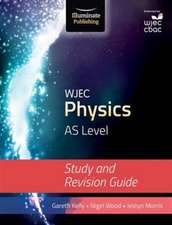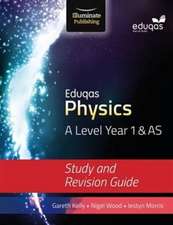Amateur Telescope Making in the Internet Age: Finding Parts, Getting Help, and More: The Patrick Moore Practical Astronomy Series
Autor Robert L. Clarken Limba Engleză Paperback – 26 oct 2010
Din seria The Patrick Moore Practical Astronomy Series
-
 Preț: 258.21 lei
Preț: 258.21 lei -
 Preț: 164.94 lei
Preț: 164.94 lei -
 Preț: 298.91 lei
Preț: 298.91 lei -
 Preț: 255.10 lei
Preț: 255.10 lei - 8%
 Preț: 581.98 lei
Preț: 581.98 lei -
 Preț: 159.16 lei
Preț: 159.16 lei -
 Preț: 282.38 lei
Preț: 282.38 lei -
 Preț: 308.55 lei
Preț: 308.55 lei -
 Preț: 309.87 lei
Preț: 309.87 lei -
 Preț: 332.98 lei
Preț: 332.98 lei -
 Preț: 251.60 lei
Preț: 251.60 lei -
 Preț: 243.94 lei
Preț: 243.94 lei -
 Preț: 183.40 lei
Preț: 183.40 lei -
 Preț: 378.09 lei
Preț: 378.09 lei -
 Preț: 302.20 lei
Preț: 302.20 lei -
 Preț: 210.01 lei
Preț: 210.01 lei -
 Preț: 212.68 lei
Preț: 212.68 lei -
 Preț: 271.39 lei
Preț: 271.39 lei -
 Preț: 252.91 lei
Preț: 252.91 lei -
 Preț: 256.64 lei
Preț: 256.64 lei -
 Preț: 264.56 lei
Preț: 264.56 lei -
 Preț: 218.84 lei
Preț: 218.84 lei -
 Preț: 257.08 lei
Preț: 257.08 lei -
 Preț: 128.86 lei
Preț: 128.86 lei -
 Preț: 301.10 lei
Preț: 301.10 lei -
 Preț: 204.78 lei
Preț: 204.78 lei -
 Preț: 307.44 lei
Preț: 307.44 lei -
 Preț: 303.07 lei
Preț: 303.07 lei -
 Preț: 258.83 lei
Preț: 258.83 lei -
 Preț: 155.25 lei
Preț: 155.25 lei -
 Preț: 193.97 lei
Preț: 193.97 lei -
 Preț: 208.26 lei
Preț: 208.26 lei -
 Preț: 279.09 lei
Preț: 279.09 lei -
 Preț: 303.51 lei
Preț: 303.51 lei -
 Preț: 252.24 lei
Preț: 252.24 lei -
 Preț: 208.51 lei
Preț: 208.51 lei -
 Preț: 214.86 lei
Preț: 214.86 lei -
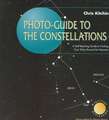 Preț: 304.58 lei
Preț: 304.58 lei -
 Preț: 220.57 lei
Preț: 220.57 lei -
 Preț: 157.32 lei
Preț: 157.32 lei -
 Preț: 250.68 lei
Preț: 250.68 lei -
 Preț: 288.98 lei
Preț: 288.98 lei -
 Preț: 261.49 lei
Preț: 261.49 lei -
 Preț: 279.09 lei
Preț: 279.09 lei -
 Preț: 160.82 lei
Preț: 160.82 lei -
 Preț: 301.72 lei
Preț: 301.72 lei -
 Preț: 254.90 lei
Preț: 254.90 lei -
 Preț: 304.38 lei
Preț: 304.38 lei -
 Preț: 256.84 lei
Preț: 256.84 lei
Preț: 157.54 lei
Nou
Puncte Express: 236
Preț estimativ în valută:
30.15€ • 31.30$ • 25.14£
30.15€ • 31.30$ • 25.14£
Carte disponibilă
Livrare economică 04-18 martie
Preluare comenzi: 021 569.72.76
Specificații
ISBN-13: 9781441964144
ISBN-10: 1441964142
Pagini: 204
Ilustrații: XII, 208 p. 70 illus.
Dimensiuni: 155 x 235 x 10 mm
Greutate: 0.34 kg
Ediția:2011
Editura: Springer
Colecția Springer
Seria The Patrick Moore Practical Astronomy Series
Locul publicării:New York, NY, United States
ISBN-10: 1441964142
Pagini: 204
Ilustrații: XII, 208 p. 70 illus.
Dimensiuni: 155 x 235 x 10 mm
Greutate: 0.34 kg
Ediția:2011
Editura: Springer
Colecția Springer
Seria The Patrick Moore Practical Astronomy Series
Locul publicării:New York, NY, United States
Public țintă
Popular/generalCuprins
Acknowledgements.- Chapter 1: Introduction.- Chapter 2: To Buy or Build a Telescope.- Chapter 3: Telescope Types and Designs.- Chapter 4: Build a Good Copyscope.- Chapter 5: The 80mm Refractor.- Chapter 6: Newtonian Telescopes.- Chapter 7: The F17 4-Inch Refractor.- Chapter 8: Focusers, Eyepieces, Barlows, and Finders.- Chapter 9: Tubes.- Chapter 10: Building a 12.5-inch Newtonian with Rotating Cage.- Chapter 11: Ergonomic Mounts.- Chapter 12: Evaluation, Quality Testing, and Optical Aberrations.- Chapter 13: Junk Collecting and Working with Modern Materials.- Appendix I: Web Suppliers of Telescope Building Parts and Materials.- Appendix II: Telescope-Building Books and Websites.- Appendix III: Polishing Log.- Appenidx IV: Units and Conversions.- Index.
Recenzii
From the reviews:
“The book is packed with help and advice; given pre-made optics, there’s advice on building a simple rich-field refractor through larger refractors and reflectors of various types, along with making all the essential parts and accessories, from tubes to mirror cells, focusers to spiders … . In summary, the book contains an eclectic mix of projects, from which the amateur telescope maker is likely to glean some perfectly good ideas.” (Peter Grego, Popular Astronomy, July-August, 2011)
“The book contains everything you need to consider when building a telescope from your own ‘scrap’; how to assess optics, design considerations and many wrinkles that assist the amateur telescope maker to meet and even exceed the engineering tolerances of commercial telescope manufacturers. This is a hugely useful book for anyone with a modicum of engineering skill … . If you have an old photocopier lens in the loft, or any unused lens looking for a noble purpose, this book is for you.” (Steve Ringwood, Astronomy Now, September, 2011)
“The book is packed with help and advice; given pre-made optics, there’s advice on building a simple rich-field refractor through larger refractors and reflectors of various types, along with making all the essential parts and accessories, from tubes to mirror cells, focusers to spiders … . In summary, the book contains an eclectic mix of projects, from which the amateur telescope maker is likely to glean some perfectly good ideas.” (Peter Grego, Popular Astronomy, July-August, 2011)
“The book contains everything you need to consider when building a telescope from your own ‘scrap’; how to assess optics, design considerations and many wrinkles that assist the amateur telescope maker to meet and even exceed the engineering tolerances of commercial telescope manufacturers. This is a hugely useful book for anyone with a modicum of engineering skill … . If you have an old photocopier lens in the loft, or any unused lens looking for a noble purpose, this book is for you.” (Steve Ringwood, Astronomy Now, September, 2011)
Notă biografică
Although Clark was born in New Hampshire, he spent his early teen years in the New York City area. There he became acquainted with the Theodore Roosevelt Museum of Natural History and at the associated Hayden Planetarium, operated, at that time, by Newton and Margaret Mayhall. Their book Skyshooting provided his first introduction to the idea that someone with only moderate skills can build good scientific instruments. The three volumes of Amateur Telescope Making, edited by Albert G. Ingalls, completed the process of addiction. Clark received a B.S. degree in Mathematics from Stanford University. He then served in the U.S. Air Force at Strategic Air Command headquarters in Nebraska. After his discharge he did graduate work in Mathematics and Computer Science at the University of Maryland. After a few years spent in the Military Operations Research industry, he migrated to a university teaching position that lasted 33 years at the University of the District of Columbia. Throughout all this time he continued to be enamored by the process of building telescopes and actually built a few as time permitted. Since retirement he has allowed the addiction to occupy a large part of his enthusiasm, as is made evident by Figure 2.3. Clark now resides in Westminster, Maryland, where he has built a hilltop observatory and is active with the Westminster Astronomical Society.
Textul de pe ultima copertă
The Internet Age is changing everything about human invention and the use of technology. The change has been compared to that of the introduction of printing. Making your own telescope isn’t what it used to be, either, thanks partly to the Internet. The old days of grinding and polishing are gone – unless you want to do it! You can now assemble a great instrument from a wide range of affordable Internet-available components, new or used. The Internet is the new parts “junkyard,” with stuff from all over the world for you to pick through, day or night.In this book you will find out what’s generally available and how to access it. You will learn how to evaluate optical components and combine them from diverse Internet sources. You will get many ideas on how to make the parts that you don’t buy or scrounge and how to restore old lenses and mirrors. And you will learn some elementary physics of designing ergonomic – comfortable – telescopes.Navigating your way around the possibilities is easy using this valuable and timely resource. With Robert Clark’s help you can get the best that the Internet has to offer. Get started now!
Caracteristici
Written for beginners who are new to observing as well as more experienced users who want a more sophisticated telescope than the one they own without spending large sums Revives the lost art of amateur telescope making, though using modern resources and existing parts Allows readers to assess and compare components, as well as answer important questions such as "How good does a mirror need to be to perform well in a telescope?" Includes supplementary material: sn.pub/extras
